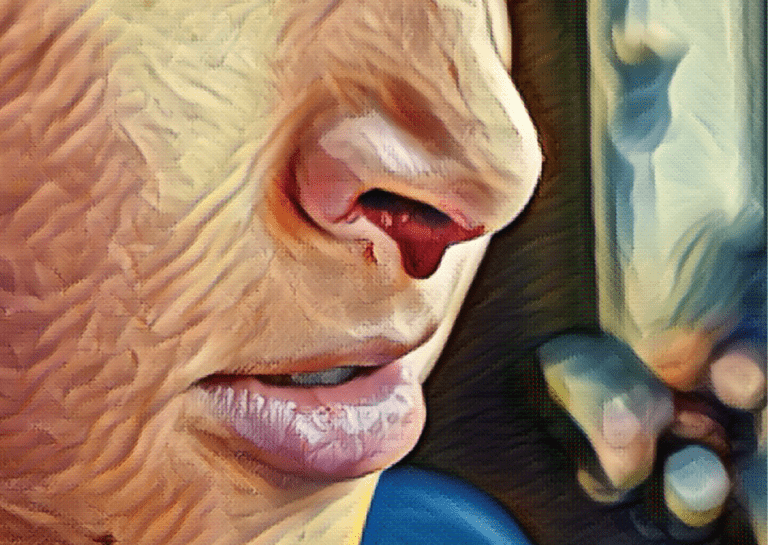Epistaxis, or bleeding from the nose, is a very common occurrence in young children. Although nosebleeds are usually harmless and rarely require hospital admission, they can be a source of concern for both parents and children.
In children younger than 2, however, nosebleeds are rarer and can indicate an underlying problem such as trauma or serious illness. Children under 10 usually experience mild nosebleeds, which can be caused when the nasal cavity becomes irritated due to atmospheric factors and minor trauma.
This article explains the causes of nosebleeds in children and discusses how to manage them when they arise.
Factors that contribute to nosebleeds
- Anatomy: The nose contains many blood vessels that allow it to carry out important functions, such as filtering, warming, and humidifying inhaled air. Because it is highly vascular, bleeding is more likely to occur.
- Hot/cold weather: Nosebleeds occur more frequently in particularly hot or cold weather and in low humidity. This is because the membrane lining the nose (the mucosa) can easily become dried out which makes it more prone to bleeding.
- Irritation: Excessive rubbing, blowing, and sneezing can irritate the nasal membrane, especially when it is dried out due to the atmospheric conditions described above. This means that nosebleeds can become more common during cold and flu season.
- Air pollution: Atmospheric pollutants in the form of airborne particles can enter the nasal cavity and cause irritation, thus increasing the risk of nosebleeds.
- Bleeding disorders: Bleeding disorders (e.g. von Willebrand disease) can cause an array of problems involving platelet counts, blood vessels, and coagulation. Problems such as these can contribute to recurring and prolonged nosebleeds.
Causes of nosebleeds in children
In addition to the contributing factors discussed above, there are several different causes of nosebleeds in children.
- Nose picking: This common habit among children can actually damage the septum and cause nosebleeds.
- Trauma: Facial and head trauma (e.g. a broken nose) caused by auto accidents, sports injuries, and home injuries are likely to cause bleeding from the nose.
- Foreign bodies: Toddlers and young children can accidentally get objects lodged in their nasal cavities. Common foreign bodies that can become lodged in the nose include beads, rubber erasers, paper wads, pebbles, marbles, beans, peas, nuts, sponges, and chalk. Such objects can cause irritation and laceration of the inner membrane of the nose, thus causing nosebleeds.
- Surgery: Nosebleeds can occur up to 2 weeks after surgery which involves the nose, such as sinus surgery or septal surgery. The bleeding usually needs to be managed by an otolaryngologist.
- Infection: Bacterial and viral upper respiratory infections such as sinusitis, as well as illnesses that cause nasal congestion, cause the nasal mucosa to become inflamed and prone to bleeding.
- Medication: Anti-inflammatory medications such as ibuprofen and aspirin can cause frequent nosebleeds that are difficult to control.
Treatment
Nosebleeds are rarely a cause for concern and usually clear up within 5 to 10 minutes. However, when nosebleeds keep happening or last an abnormally long time, it is best to see a doctor.
Additionally, nosebleeds are a rare occurrence in children younger than 2 and require prompt treatment to determine whether there is a more serious underlying cause, such as trauma or illness.
When treating nosebleeds, a medical professional will need to find out the following information:
- When the nosebleed began
- Whether there have been previous visits to the emergency department for nosebleeds
- Whether it is unilateral (from one side only) or bilateral (from 2 sides)
- The amount of blood that has been lost
- Whether there is blood in the mouth
- The type of measures that have been taken to control the bleeding
- Whether there is trauma involved (e.g. nose picking)
- Whether there is a history of nasal congestion or a possibility of a foreign body becoming lodged in the nose
- Whether there has been recent nasal surgery
This information helps doctors to determine the underlying cause of the nosebleed and to detect any illnesses or bleeding disorders that might be responsible.
References
- Brown NJ, Berkowitz RG. Epistaxis in healthy children requiring hospital admission. Int J Pediatr Otorhinolaryngol. 2004 Sep;68(9):1181-4. doi: 10.1016/j.ijporl.2004.04.015. PMID: 15302149.
- McIntosh N, Mok JY, Margerison A. Epidemiology of oronasal hemorrhage in the first 2 years of life: implications for child protection. Pediatrics. 2007 Nov;120(5):1074-8. doi: 10.1542/peds.2007-2097. Epub 2007 Sep 24. PMID: 17893187.
- Bernius M, Perlin D. Pediatric ear, nose, and throat emergencies. Pediatr Clin North Am. 2006 Apr;53(2):195-214. doi: 10.1016/j.pcl.2005.10.002. PMID: 16574522; PMCID: PMC7126702.
- Stoner MJ, Dulaurier M. Pediatric ENT emergencies. Emerg Med Clin North Am. 2013 Aug;31(3):795-808. doi: 10.1016/j.emc.2013.04.005. Epub 2013 Jun 14. PMID: 23915604.
- Bray D, Monnery P, Toma AG. Airborne environmental pollutant concentration and hospital epistaxis presentation: a 5-year review. Clin Otolaryngol Allied Sci. 2004 Dec;29(6):655-8. doi: 10.1111/j.1365-2273.2004.00878.x. PMID: 15533154.
- Desrosiers AE 3rd, Thaller SR. Pediatric nasal fractures: evaluation and management. J Craniofac Surg. 2011 Jul;22(4):1327-9. doi: 10.1097/SCS.0b013e31821c932d. PMID: 21772190.
- Halderman AA, Sindwani R, Woodard TD. Hemorrhagic Complications of Endoscopic Sinus Surgery. Otolaryngol Clin North Am. 2015 Oct;48(5):783-93. doi: 10.1016/j.otc.2015.05.006. PMID: 26318796.
- Delgado EM, Nadel FM. Epistaxis. In: Fleisher and Ludwig’s Textbook of Pediatric Emergency Medicine, 7th edition, Shaw KN, Bachur RG (Eds), Wolters Kluwer, Philadelphia 2016. p.149.
